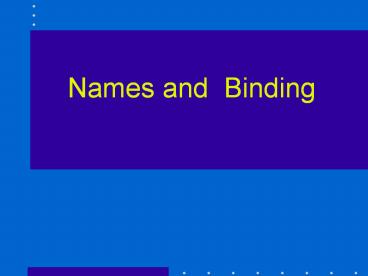Names and Binding - PowerPoint PPT Presentation
Title:
Names and Binding
Description:
Variables are abstractions for memory cells in the computer. ... Flexibilty, generic code development - Loss of ability to detect type errors ... – PowerPoint PPT presentation
Number of Views:40
Avg rating:3.0/5.0
Title: Names and Binding
1
Names and Binding
2
vonNeumann Architecture
- memory where data and instructions are
stored - processor where computations are
carried out
3
Variables
Variables are abstractions for memory cells in
the computer. Programmers think of variables as
names for memory locations.
4
Variables
Variables can be characterized by a number of
attributes including
- name
- name
- address
- value
- type
- lifetime
- scope
5
Variables Names
Names are associated with variables, but also
with labels, subprograms, and formal parameters
6
Variables Names
Design Issues
- maximum name length
- special or connector characters
- case sensitivity
- are the special words treated as reserved
words or keywords?
7
Variables Names
Reserved word - a special word of a
programming language that cannot be used as
a name Keyword - a word that has special
meanings in certain contexts Predefined
name - have predefined meanings but can be
redefined by the user
8
Variables
Variables can be characterized by a number of
attributes including
- name
- address
- address
- value
- type
- lifetime
- scope
9
Variables Address
Address - the memory address with which a
variable is associated, also called
its l-value
Example x number 2
10
Variables Address
Issues of complexity with the concept of
addresses
Same name, different address - example local
variables in different
functions
Same address, different name (alias) examples
variant records, unions, pointers, global
variables, equivalence statements
11
Variables
Variables can be characterized by a number of
attributes including
- name
- address
- value
- value
- type
- lifetime
- scope
12
Variables Value
The value of a variable is the contents of the
memory cell or cells associated with the
variable. Also referred to as the r-value
Example x number 2
13
Variables
Variables can be characterized by a number of
attributes including
- name
- address
- value
- type
- type
- lifetime
- scope
14
Variables Type
Determines
1. The range of values which can be stored
in a variable 2. The operations which can
legally be performed on the variable
15
Variables
Variables can be characterized by a number of
attributes including
- name
- address
- value
- type
- lifetime
- lifetime
- scope
16
Variables Lifetime
The lifetime of a program variable is the time
during which that variable has a particular
memory cell associated with it.
The lifetime of a variable may begin
- at the start of program execution
- when a function is called (local variables)
- when the variable is created dynamically
during program execution (new, malloc)
17
Variables
Variables can be characterized by a number of
attributes including
- name
- address
- value
- type
- lifetime
- scope
- scope
18
Variables Scope
The range of statements in which the variable is
visible The scope rules of a language determine
how a particular occurrence of a name is
associated with a variable
19
Binding
20
The Concept of Binding
A binding is the association of an entity with an
attribute or of a symbol with an operation. A
binding establishes the choice of a property from
a set of properties The time at which a binding
takes place is called binding time.
21
Binding Times
Binding can take place at
- language design time
- language implementation time
- compile time
- link time
- load time
- run time
22
Binding Times
X X 10
- set of allowable types for X (language design
time)
- set of possible values for X (language
implementation time)
- type of X (compile/translation time)
- value for X (run-time)
- physical address for X (load time)
23
Binding of Attributes to Variables
Static binding - occurs before run time and
remains unchanged throughout the
program Dynamic binding - occurs during run
time or can change during the course of
program execution
24
Type Binding
Type declarations - implicit and
explicit Dynamic type binding - the type of a
variable is bound when it is assigned a value in
an assignment statement
25
Storage Bindings and Lifetime
Static variables
Stack dynamic variables
Explicit heap-dynamic variables
Implicit heap-dynamic variables
26
Storage Bindings and Lifetime
Static variables
- bound to memory locations before
- program execution begins
- remain so until program execution ends.
Efficiency History sensitive subprogram
variables - Reduced flexibility
Examples all variables in Fortran IV
static variables in C, C, Java
27
Storage Bindings and Lifetime
Stack dynamic variables
- bound to memory locations when their
- declaration statements are elaborated
Enables recursion Shared storage space -
Run-time overhead for memory
allocation/deallocation
Examples subprogram variables in Fortran 77
90, Pascal, C, C
28
Storage Bindings and Lifetime
Explicit heap-dynamic variables
- bound to memory locations at run-time
- when specified by the programmer
- in some languages, deallocation is
- specified by the programmer
Enables structures to grow or shrink -
Difficulty of correct memory management -
Run-time overhead for memory access,
allocation, and deallocation
Examples new in Java, C
malloc in C
29
Storage Bindings and Lifetime
Implicit heap-dynamic variables
- bound to memory locations when they
- are assigned values
Flexibilty, generic code development - Loss of
ability to detect type errors - Run-time
overhead for maintaining dynamic attributes
Examples variables in many interpretive
environments flex arrays in
ALGOL 68

